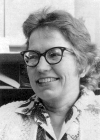


November 23, 1917 - December 20, 1988
Elizabeth L. Scott was born in Fort Sill, Oklahoma, but her family moved to Berkeley, California, when she was 4 years old. She attended school at University High School associated with the University of California, Berkeley. There she was the only girl in the advanced mathematics courses. Upon graduation she continued on to study astronomy at both the undergraduate and graduate levels at the University of California at Berkeley. All of her undergraduate teachers were men, but she did have occasion to meet Pauline Sperry, one of only two women in the mathematics department, when she was in graduate school.
There were not many opportunities for women in astronomy at this time. Most were just assistants to male staff members, and often forbidden from using the telescopes themselves. Scott actually relinquished her teaching assistantship in the astronomy department to work as a research assistant with Jerzy Neyman, a member of the statistics group within the mathematics department at Berkeley. She received her Ph.D. in 1949 with a dissertation in two parts written under the supervision of Donald Trumpler. Part I was on "Contribution to the Problem of Selective Identifiability of Spectroscopic Binaries" and Part II was on "Note on Consistent Estimates of the Linear Structural Relation Between Two Variables." In 1951 she was appointed to the faculty in the Department of Mathematics at Berkeley where she spent the rest of her professional career.
Neyman and Scott developed a lasting friendship and collaboration that complemented their background and training in statistics and astronomy. Scott wrote many papers in astronomy, both before her Ph.D. in 1949, and afterwards, some joint work with Neyman. Billard and Ferber write that:
"Not surprisingly, the first foray into the statistical world was in her original area, and during the 15-year span from 1949-1964 she published over 30 additional papers in astronomy. The earlier ones focused on the use of statistical tools to answer important questions in that field, followed by a shift to work using astronomy as the motivation for and application of statistical ideas. This series of papers centered on the premise that the universe and its elements were products of random processes.
....
Later papers extended the ideas [about distribution of galaxies] to more than two regions in space, regions that may or may not be disjoint, as well as extensions to many other statistical properties. This included the important problem of discriminating between cosmological theories. Clusters of galaxies are important for measuring the geometry of the universe. When more distant clusters are observed, they tend to contain more galaxies. This observational bias means that galaxies of any rank will be intrinsically brighter in these more distant systems. This observational bias or selection effect was first pointed out by Elizabeth Scott and is commonly known as the 'Scott effect.'"
Scott also worked in other areas of statistics. She wrote over 30 papers in weather modification research analysis, particularly rain stimulation, in the 1960s and 1970s. Meteorological challenges created problems in designing appropriate statistical experiments. As noted by Billard and Ferber
"Scott's work showed effectively just how much statistical theory still remained to be developed in order to understand better meteorological issues, but is also suggested that further collaboration between meteorologists and statisticians could perhaps ultimately resolve the remaining questions."
Through her involvement with the Committee on National Statistics of the National Research Council, part of the National Academy of Sciences, Scott worked on a study of skin cancer and the problem of modeling how skin cancer increases with increased intensity of ultraviolet radiation. She also used her statistical training as a pioneering advocate for the promotion of equal opportunities and equal pay for women in the academic profession. The Higher Education Salary Evaluation Kit that she helped develop for the American Association of University Professors has been widely used to identify and eliminate salary inequities.
Scott received many professional honors and served on numerous committees and boards of national statistical organizations. In 1980 she received the Outstanding Statistician of the Year Award from the Chicago chapter of the American Statistical Association. In 1981 she was elected an Honorary Fellow of the Royal Statistical Society. She served as Vice President of the American Association for the Advancement of Science (1970-1971), as President of the Institute of Mathematical Statistics (1977-1978), Vice President of the International Statistical Institute (1981-1983), and President of the Bernoulli Society for Mathematical Statistics and Probability (1983-1984).
In 1992 the Committee of Presidents of Statistical Societies established the Elizabeth L. Scott Award, presented every two years at the Joint Statistical Meetings. The description of this award reads:
In recognition of Elizabeth L Scott's lifelong efforts in the furtherance of the careers of women, this award is granted to an individual who has helped foster opportunities in statistics for women by developing programs to encourage women to seek careers in statistics; by consistently and successfully mentoring women students or new researchers; by working to identify gender-based inequities in employment; or by serving in a variety of capacities as a role model. This award, first awarded in 1992, is given every other year in even years, and consists of a plaque and a cash award.
The first recipient of the Elizabeth L. Scott award was Florence Nightingale David.